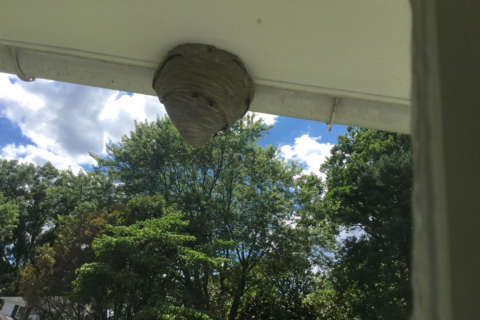Della in Baltimore writes: “Many years ago, the next-door neighbor planted a flowering cherry tree between his house and ours. The roots have now traveled to our side of the yard, and grass will no longer grow in that area. How do we get the grass to grow?”
Whether the roots are visible above ground or you’re just guessing that underground roots are the cause, cover the area an inch or two deep with compost or topsoil and sow a fine fescue grass seed into that new soil between mid-August and mid-September.
Fine fescues are the most shade-tolerant of the cool-season grasses. Take samples of the rest of your lawn to an independent garden center that has a good lawn person. Ask them to make the best match possible, and be sure that it’s a brand name high-quality seed that you’ll be able to purchase again, as all fescues need reseeding every few years, always in the fall; never in the spring.
Afterward, be prepared to water that area more frequently than the rest of the lawn. Be especially vigilant about supplying extra water in dry times to compensate for the competition from the tree roots. And don’t subject that area to a lot of foot traffic; fine fescues are not a turf for touch football.
If the area in question doesn’t get at least four hours of sun a day, it would be wiser to install a shade-loving ground cover and use edging to make it look like a deliberate planting. Or hardscape the area and put container plantings or a grill on top, or a shed.
The really hungry, hungry caterpillar
Kathleen in Ashburn, Virginia, writes: “I noticed that my pepper plants have been eaten by rather-plump green caterpillars. Is it okay to kill them? I try and keep our yard and garden friendly to insects, but I don’t want them to get over to our other plants.”
The photo that Kathleen included clearly shows the dreaded tomato hornworm — the largest and most ravenous caterpillar in our region. Despite their massive size, hornworms are hard to see because they are the exact same color as the leaves of the tomato and pepper plants they consume.
You can see this one clearly because it has eaten virtually all of the plant already.
Hornworms are a serious pest; they can defoliate a good-sized tomato plant in under a week. So if you see a lot of missing leaves and branches, run your hands up and down the sides of the plant until you feel something big and soft, and then squish it.
But don’t squish hornworms with spines on their back
Kathleen doesn’t want those critters to get over to her other plants. That’s a rational fear, Kath.
The giant tomato hornworm that ate your pepper plants to the bone is much better known as a ravager of tomatoes, and the tomato plants in your garden would be their next stop. If the hornworm is “naked,” like the one in the photo you sent, yes — squish them without remorse.
But if the caterpillar has white spines on its back, prune away the branch it’s on and move it away from the vegetable garden into a shady spot; ideally in the crook of a tree. Those spines are the egg cases of a tiny parasitic wasp. Their actual size is about the same as the period at the end of a newspaper or book sentence.
The baby wasps that emerge from the carcass of the unlucky caterpillar will attack more pest caterpillars in your garden the same way.
Don’t rely on internet lore to defeat yellowjackets
Jonathan in Takoma Park writes: “Now that summer is here, the ground under our patio is once again home to a nasty nest of yellowjackets. I found what looked like a clever way to get rid of them online, involving a shallow baking pan, some soapy water and a couple of flat boards, smeared with cat food as bait. The yellowjackets are supposed to come to the bait, fall into the water and drown. But there are no yellowjackets in the water yet. How come this trick isn’t working for me?”
Because this weird bit of advice is the garden equivalent of fake news, Jon. There’s no reason to believe it would work for anybody.
Instead, buy two commercial yellowjacket (or wasp/hornet) traps. They’re inexpensive and available at any hardware store or garden center.
Bait one of the traps with a smelly protein, like cat food. Bait the other with something smelly and sweet, like an overripe peach. Then hang both near the nest opening. At times in the season, yellowjackets crave protein, such as big, fat pest caterpillars. Other times, they crave sugar, such as raspberries and blueberries.
If they go to only one of your traps, put up more with the same kind of bait. If they go for both, put up more traps, each baited with a smelly meat (spoiled ham works great) or almost-rotting fruit, not sugary drinks. I would not mix them into the same trap. The yellowjackets (and often, lots of pestiferous flies) will enter the traps, but then they can’t get out.
You’ll catch lots.
Yellowjackets 101
Jonathan’s statement that “the ground under our patio is once again home to a nasty nest of yellowjackets” makes me suspicious. Yellowjackets don’t reuse old nests; the next generation always builds a new one.
Now this area might just be the perfect place for them, (close to the shops; good school district; working Metro station), and maybe there’s half a dozen old nests down there; but I first recommend that Jon make sure of his ID. They could be harmless native bees, in which case you’d do nothing and reap their pollinating reward. Or they could be mud dauber or paper wasps, in which case a few traps would take care of things very well.
But if they are aggressive yellowjackets (smooth, almost-metallic yellow body; slightly bigger than a honeybee), begin the process by reducing their numbers with commercial wasp traps.
You can also try a homemade one.
Use a Phillips head screwdriver to punch a single hole in the lid of a quart-sized glass jar, milk jug or large spring water bottle, put some bait in the container, screw the lid back on, place in position near the nest and back away slowly. DON’T RUN.
Then, if the single hole the wasps all use to come and go is visible and accessible, cover it with a glass bowl late at night or early morning (when the guards will be absent or slow) to smother the nest.
You can also use an old canister vacuum to empty the nest. Fit the vacuum with an empty bag, drop the hose near the hole (again, late or early; not when they’re active), turn it on from a distance and the nasties will attack that noisy intruder until they’ve all been sucked into the bag. When no more wasps appear, put duct tape over the hose end before turning the machine off and then just sit the machine in a safe place until they all expire.







